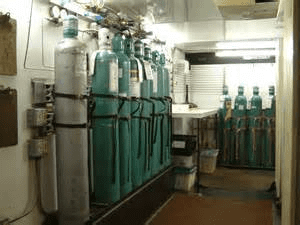3j. Monitoring Coal Plant Emissions
In 1996, the Clean Air Act was amended to require continuous emissions monitoring. In response, Control Emissions Monitoring Systems (CEMS) were placed in coal-fired plant chimneys to monitor the amounts of SOx, NOx, and CO2 released into the atmosphere. The probes collect real-time data, which is used to ensure compliance to all regulations. The systems are monitored in the following ways:
Daily Calibration
The probes of the CEMS are calibrated each day with gas samples. These samples contain known amounts of SOx, NOx, CO2, and particulate matter.
Quarterly Testing
The amounts of pollutants, such as sulfur compounds, vary in lignite coal. Each quarter, the probes are calibrated to ensure they have an adequate low and high testing range.
Annual Testing
Each year, independent stack testers check the CEMS to ensure they are taking accurate measurements. The testing company places their own probes next to the power plant probes in the chimney, and the data readings are compared.


